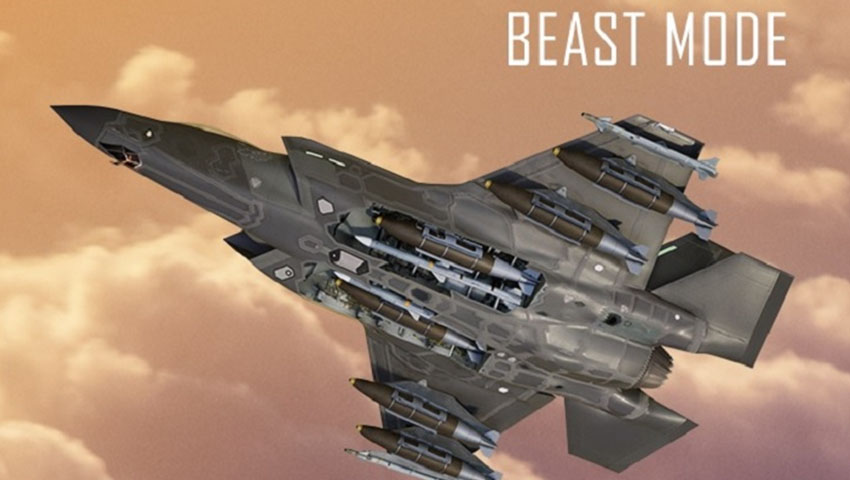A key selling point of the F-35 was its role as a ‘strike’ fighter. For Australia, the F-35 will provide an unprecedented combination of low-observability, sensor fusion and situational awareness, each of which will enhance the aircraft’s role as a strike fighter.
To continue reading the rest of this article, please log in.
Create free account to get unlimited news articles and more!
For the F-35, the combination of low-observability, sensor fusion, situational awareness and strike capability will ensure that the fifth-generation fighter remains the undisputed king of the skies, well into the 2040s.
Technology is a powerful piece of the intricate jigsaw that makes up the capability of the F-35, but when it comes to achieving air superiority and prosecuting ground strikes with pinpoint accuracy, the platform's multi-role heritage and the versatility this affords provides it with a lethal combination.
The versatility of the F-35 is best defined by its two distinct, equally potent load-outs, designed for highly-specialised missions ranging from penetrating enemy air defences and gaining air superiority to deep, precision strike against well defended, integrated enemy air defence networks. These two modes are 'stealth' and 'beast' modes.
- Stealth mode: Leverage's the low-observability profile and characteristics of the aircraft to enhance its lethality by ensuring that the plane can't be seen by enemy air, land or sea-based radars, reducing the probability of enemy intercept, allowing the F-35 to prosecute its strike with unrivalled competence. In stealth mode, the aircraft can be armed with a range of weapons, loaded within the internal weapons bays to maintain the stealth profile, these include, up to 5,700 pounds of internal ordnance:
- Four AIM-120 AMRAAMs for air-to-air only missions, that is entering contested airspace and establishing air superiority;
- Two AIM-120 AMRAAMS and two GBU-31 2,000-pound bombs in the air-to-air and air-to-surface mission configuration, allowing the aircraft to enter airspace where air superiority has been established and conduct precision strikes as needed.
- Beast mode: For when discretion has gone out the window and air superiority has been guaranteed, the F-35 takes on an entirely different role and character. Beast mode provides the platform with unrivalled strike capability for an aircraft of its size, enabling the F-35 to carry up to 22,000 pounds of internal and external ordnance, including:
- 14 AIM-120 AMRAAMs and two AIM-9X Sidewinders for establishing air superiority in extremely contested environments;
- Two AIM-120 AMRAAMS, two AIM-9X Sidewinders and six GBU-31 2,000-pound bombs in the air-to-air and air-to-surface mission configuration.
Former general manager for the F-35 Program with Lockheed Martin, now vice president and general manager, Lockheed Martin Skunk Works, Jeff Babione, was confident in the capabilities of the F-35, saying, "Whether it’s the first day of the war when we need the stealth, or the second or third … whenever the F-35 is called, it can do the mission."
The aircraft's AIM-120 AMRAAM missiles in themselves are developed for flexibility in operations, being used for air-to-air and surface launch engagements. The missiles have a range over 20 miles, and incorporates active radar with an inertial reference unit and micro-computer system, allowing the missile to depend less on the fire-control system of the aircraft.
The GBU-31 JDAMs that the F-35s will use is a 2,000-pound air-to-surface weapon that autonomously navigates to designated target coordinates. These coordinates can be loaded before takeoff, altered by aircrew manually before release, or automatically entered through target designation with onboard aircraft sensors.
Additionally, the AIM-9X Sidewinder missile, also manufactured by Raytheon, is a tri-use missile that can be used in air-to-air, air-to-surface or surface-to-air applications without any modifications and has an operational range of over 20 miles.
With an operational range of 2,800 kilometres and combat radius of 1,390 kilometres, F-35 pilots are supported by 360-degree access to their environment thanks to advanced avionics, which allow a level of tactical optimisation unseen in fighter aircraft.
A key role of the fifth-generation platform will include supporting legacy fourth-generation platforms, like F/A-18s, F-15s, F-16s and Eurofighter Typhoons to engage enemy aircraft, ground and forces through combination of penetrating low-observability, sensor fusion and communications providing unprecedented levels of situational awareness throughout the task force.
The F-35 is able to share all of this information with other aircraft and operation centres to expand situational awareness across an entire network, earning the nickname as a "quarterback aircraft".
JSF also features a suite of advanced electronic warfare capabilities, which allow pilots to locate and track enemy forces, jam radars and disrupt attacks with extreme effectiveness.
The entire capability of the F-35 is built with the understanding that aircraft should not be limited to a single capability. Traditionally speaking, air-to-air combat, air-to-ground strikes, electronic attacks, intelligence gathering, surveillance and reconnaissance all required specialised aircraft.

 Login
Login







